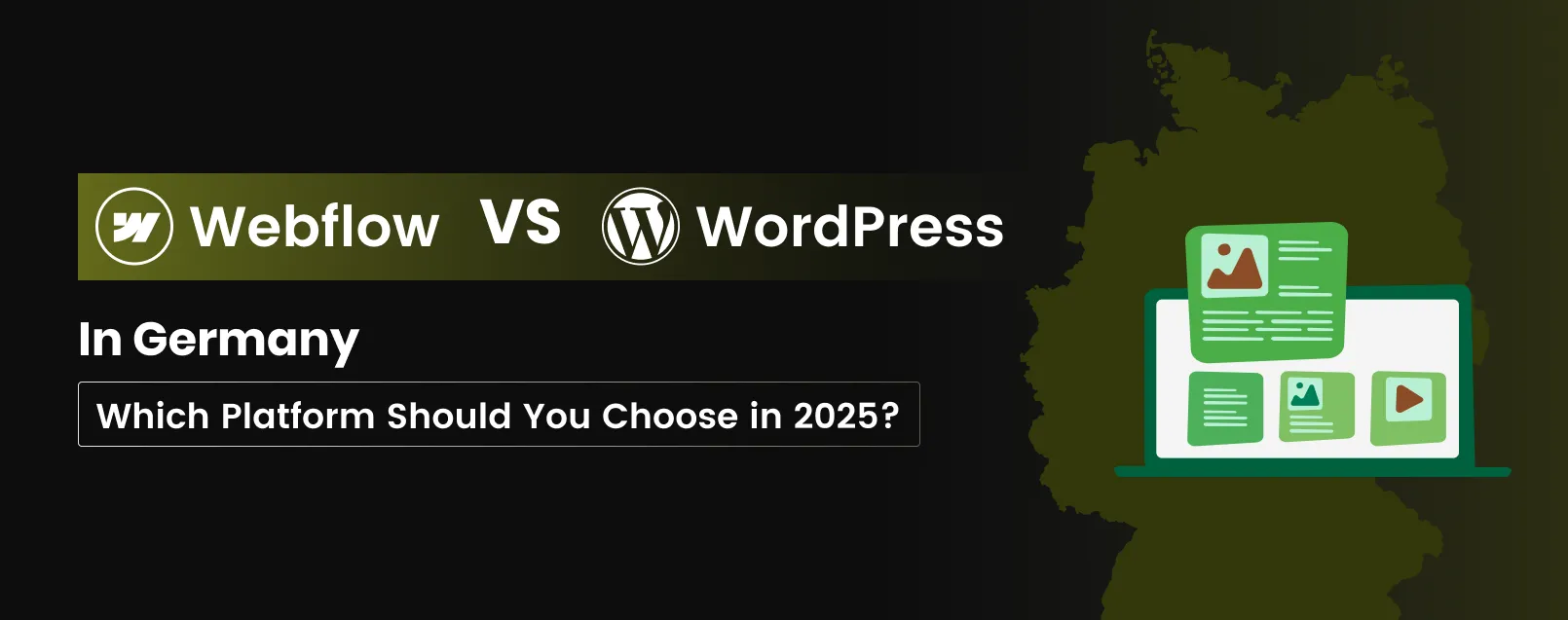

Webflow vs WordPress in Germany: Which Platform Should You Choose in 2025?

When it comes to building websites in Germany, Webflow and WordPress are two of the most popular platforms for entrepreneurs, startups, and marketing teams. Each platform has its strengths and weaknesses, and choosing the right one depends on your business needs, technical requirements, and long-term goals.
In this article, we’ll provide a detailed comparison of Webflow vs WordPress, focusing on Germany's market, highlighting the specific factors that matter most for German businesses in 2025.
Quick Overview: Webflow vs WordPress
What is Webflow?
Webflow is a modern, no-code platform that allows users to design, build, and launch responsive websites without coding. It’s a popular choice for those looking for complete control over website design and performance.
In Germany, Webflow is particularly favored by:
- Agencies looking for pixel-perfect design control
- SaaS companies that need fast, interactive sites
- Startups aiming for modern and responsive websites
What is WordPress?
WordPress is an open-source CMS that powers more than 40% of websites globally. In Germany, it’s commonly used for:
- Content-heavy platforms (e.g., blogs, news portals)
- Websites that require deep customization via plugins or developers
- Long-established businesses that rely on plugins for various functionalities
While WordPress offers greater flexibility, it also requires more hands-on management, making it suitable for companies that have access to developers or technical teams.
Key Considerations for German Businesses
1. Performance and Core Web Vitals
As Google continues to prioritize Core Web Vitals in search rankings, website speed, interactivity, and stability are crucial for German businesses.
- Webflow offers lightning-fast load times, a built-in content delivery network (CDN), and automatic optimizations that help ensure excellent user experience and SEO performance.
- WordPress can match Webflow’s performance, but it requires proper setup, caching plugins (like WP Rocket), and third-party hosting for optimized speed.
Verdict: Webflow is more streamlined for performance, requiring less configuration for optimal results.
2. SEO Optimization
SEO is a critical factor for any business operating in Germany, especially in competitive industries. Webflow offers native SEO features, including meta tags, URL management, and sitemap generation. It also supports high-performance features like automatic image compression.
- WordPress, on the other hand, relies on external SEO plugins like Yoast or RankMath to handle most of the SEO tasks. While these plugins are robust, they add extra layers of complexity and plugin maintenance.
Verdict: Webflow is built for SEO success with minimal maintenance. WordPress provides more customization but needs external plugins and optimization to reach its full SEO potential.
3. Design Flexibility and UI/UX
For businesses in Germany, a visually appealing and well-structured website is critical—especially for industries that prioritize high-end user experiences (UX).
- Webflow is unmatched in its design freedom. It gives you pixel-perfect control over the visual layout and interactions, making it ideal for companies that want to deliver a unique, brand-driven experience.
- WordPress is often limited by themes and plugins. Customizing the design usually requires frontend developers, and updates to themes or plugins can lead to conflicts or design inconsistencies.
Verdict: If your German brand requires a sleek, modern design with intricate animations or unique layouts, Webflow is the better choice.
4. Security and Data Compliance (GDPR)
Germany is known for its strict data protection laws (GDPR), and businesses operating in Germany must ensure their websites are compliant with these regulations.
- Webflow includes SSL, data encryption, and privacy-focused features built into the platform. Webflow’s hosting and security infrastructure align with GDPR, making it a secure choice for German businesses.
- WordPress requires additional security measures. While some security plugins (e.g., Wordfence) offer protection, it’s ultimately up to the business to configure the platform for GDPR compliance.
Verdict: Webflow’s built-in compliance features make it the easier choice for GDPR-focused businesses.
5. Developer Resources in Germany
Germany has a robust developer ecosystem. WordPress developers are widely available, making it a cost-effective choice for large enterprises or custom projects. WordPress also benefits from an extensive library of plugins and tools, giving developers the flexibility to implement highly customized features.
However, Webflow is quickly gaining traction among agencies, designers, and developers who prefer no-code solutions with design control. With Webflow, businesses can build and manage their sites independently, without needing extensive technical support.
Verdict: WordPress is still the go-to for custom projects, but Webflow is ideal for teams that want to avoid heavy development work and maintain full control over their design.
Real-World Use Cases in Germany
At UnFoldMart, we’ve helped several brands in Germany and globally build high-performing websites using both Webflow and WordPress. Here are some examples:
Atmosly (Webflow)
We developed Atmosly.com, a DevOps platform based in the U.S., using Webflow. Their website needed to handle complex product information and integrate seamlessly with third-party tools. Webflow’s flexibility and performance made it an ideal choice for Atmosly’s technical audience.
Wishlink (Webflow)
For Wishlink, an India-based fashion-tech brand, we leveraged Webflow to create a visually striking website that highlights their unique value proposition. The Webflow platform’s customization options allowed us to showcase their product catalog and influencer partnerships with minimal friction.
SquareOps (WordPress)
SquareOps, an India-based startup, required a content-driven website with extensive blog integration. WordPress was the best choice for scaling their editorial content, as it offered full backend control and an easy-to-use CMS for the marketing team.
Cost Comparison for German Businesses
Verdict: Webflow provides an all-in-one pricing structure that reduces hidden costs, while WordPress can be more affordable initially but requires ongoing developer support.
CMS and Content Workflows
Both Webflow and WordPress have strong content management systems, but they cater to different use cases:
- Webflow’s CMS is perfect for businesses that want to showcase products, services, or portfolios without the overhead of plugin management. It’s ideal for teams focused on marketing-first, design-first sites.
- WordPress excels when it comes to content-heavy websites, blogs, and large-scale publishing operations. If your team requires advanced editorial workflows (multi-author blogs, comment sections, etc.), WordPress remains the leader.
Verdict: For marketing-driven sites → Webflow. For content-driven sites → WordPress.
Which One is Better for Germany?
For most German businesses aiming for speed, performance, and design control, Webflow is the ideal platform in 2025. It offers GDPR compliance, faster load times, and minimal maintenance—all while delivering beautiful, high-performing websites.
If your focus is on publishing, editorial control, or working with third-party integrations, WordPress remains the best choice.
Build Your Website the Right Way
At UnFoldMart, we specialize in both Webflow and WordPress. Whether you need a fast, SEO-optimized Webflow site or a highly customizable WordPress platform, we’ve got you covered.
Explore our portfolio and book a free consultation to discuss how we can elevate your digital presence.
FAQs
Got Questions? We’ve Got Answers – Clear, Simple, and Straight to the Point
Yes. Webflow includes SSL, secure hosting, and built-in privacy features that align with Germany’s strict GDPR requirements.
Yes. Migration is possible with proper planning to preserve SEO, redirects, and content workflows. Agencies like UnFoldMart provide this service.
Many startups, SaaS companies, and agencies in Germany choose Webflow for speed and design freedom, while WordPress remains strong for blogs and content-heavy sites.
Webflow is ideal for GDPR-compliant, design-driven sites, while WordPress suits content-heavy platforms that need advanced editorial control.
Still have questions?
No question is too small—let’s talk
We don’t just execute—we create impact. Whether you need cutting-edge campaigns, high-performing strategies, or breakthrough brand growth, we’re the team to make it happen.
Let’s turn ideas into action and results into success.






.webp)